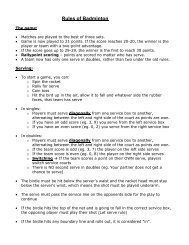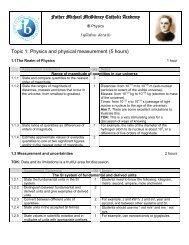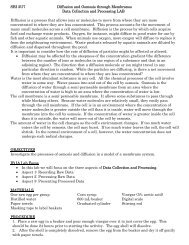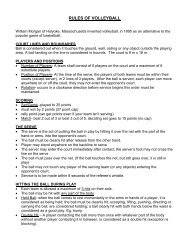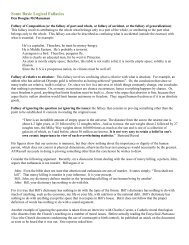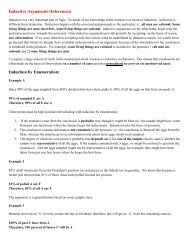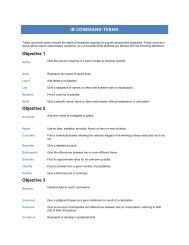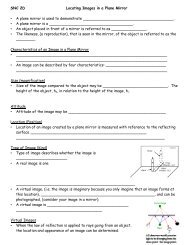Chemistry Review Manual 2
Chemistry Review Manual 2
Chemistry Review Manual 2
You also want an ePaper? Increase the reach of your titles
YUMPU automatically turns print PDFs into web optimized ePapers that Google loves.
Table 3.3. Oxoacids and oxoanions<br />
Oxoacid 1 st Conjugate Base 2 nd Conjugate Base 3 rd Conjugate Base<br />
H 2 CO 3<br />
carbonic acid<br />
HCO 3<br />
−<br />
hydrogen carbonate<br />
(bicarbonate)<br />
CO 3<br />
2−<br />
carbonate<br />
HNO 2<br />
nitrous acid<br />
NO 2<br />
−<br />
nitrite<br />
HNO 3<br />
nitric acid<br />
NO 3<br />
−<br />
nitrate<br />
H 3 PO 3<br />
phosphorous acid<br />
H 2 PO 3<br />
−<br />
dihydrogen phosphite<br />
HPO 3<br />
2−<br />
hydrogen phosphite<br />
PO 3<br />
3−<br />
phosphite<br />
H 3 PO 4<br />
phosphoric acid<br />
H 2 PO 4<br />
−<br />
dihydrogen phosphate<br />
HPO 4<br />
2−<br />
hydrogen phosphate<br />
PO 4<br />
3−<br />
phosphate<br />
H 2 SO 3<br />
sulfurous acid<br />
HSO 3<br />
−<br />
hydrogen sulfite<br />
SO 3<br />
2−<br />
sulfite<br />
H 2 SO 4<br />
sulfuric acid<br />
HSO 4<br />
−<br />
hydrogen sulfate<br />
SO 4<br />
2−<br />
sulfate<br />
HClO<br />
hypochlorous acid<br />
OCl −<br />
hypochlorite<br />
HClO 2<br />
chlorous acid<br />
ClO 2<br />
−<br />
chlorite<br />
HClO 3<br />
chloric acid<br />
ClO 3<br />
−<br />
chlorate<br />
HClO 4<br />
perchloric acid<br />
ClO 4<br />
−<br />
perchlorate<br />
Note that some elements as central atoms (e.g. N, S, P and Cl) have more than one oxoacid.<br />
When there are two such species they are labeled ...ous acid and ...ic acid (e.g. nitrous and nitric<br />
acids). The oxoacid with more O atoms (for which the central atom has the highest oxidation<br />
number) is labeled ...ic acid, while that with fewer O atoms is labeled ...ous acid. The<br />
corresponding oxoanions are labeled ...ite and ...ate. In the case of chlorine, there are four<br />
oxoacids. The middle two (with respect to number of O atoms) acids are chlorous and chloric<br />
acid, respectively. That with one fewer O than chlorous acid is called hypochlorous acid. That<br />
with one more O than chloric acid is called perchloric acid. The conjugate base to hypochlorous<br />
acid is hypochlorite, while the conjugate base to perchloric acid is perchlorate. Other common<br />
oxoanions include the powerful oxidizing agents, dichromate, Cr 2 O 7 2− , and permanganate,<br />
MnO 4 − .<br />
Organic Acids and Bases<br />
There are many organic acids. The simplest are the alkanoic (carboxylic) acids derived from the<br />
alkanes. The alkanes have the chemical formula, C n H 2n+2 . For example, for n = 1 and 2 we have<br />
methane, CH 4 , and ethane, C 2 H 6 , respectively. The alkanoic acids are obtained by replacing 3 H<br />
atoms attached to one of the end carbon atoms with a doubly bonded O and an OH group (the O<br />
Page 26 of 88






